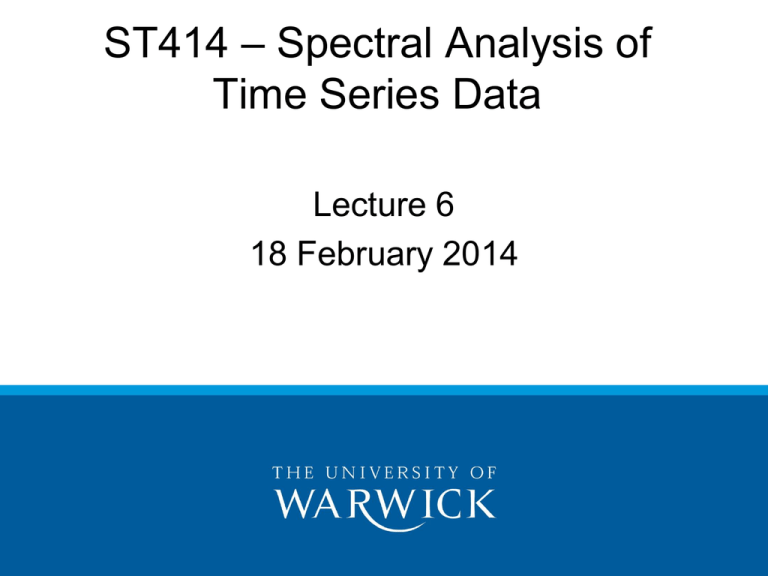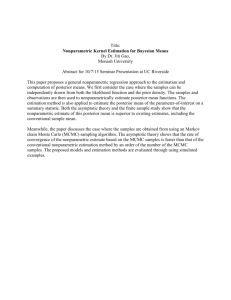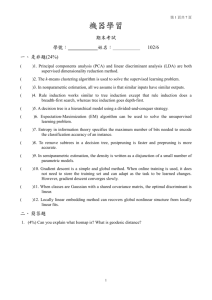– Spectral Analysis of ST414 Time Series Data Lecture 6
advertisement

ST414 – Spectral Analysis of Time Series Data Lecture 6 18 February 2014 Last Time • • • • Introduction to bivariate processes The cross-covariance function The cross-spectrum Coherence analysis 2 Today’s Objectives • • • • Asymptotics for the spectral density matrix Estimating VAR parameters Causality The VAR spectral density matrix 3 Nonparametric Estimation Given a bivariate time series (𝑋1 t , 𝑋2 t )′, construct the bivariate DFTs 𝑑 𝜔𝑗 = (𝑑𝑋1 𝜔 , 𝑑𝑋2 𝜔 )′, where 𝑇 𝑑𝑋𝑗 𝜔𝑗 = 𝑇 −1/2 𝑋𝑗 𝑡 exp(−𝑖2𝜋𝜔𝑗 𝑡) 𝑡=1 4 Nonparametric Estimation The periodogram matrix is 𝑰 𝜔𝑗 = 𝑑 𝜔𝑗 𝑑 𝜔𝑗 ∗ 5 Nonparametric Estimation The smoothed periodogram matrix is 𝒇 𝜔𝑗 1 = 2𝑀 + 1 𝑀 𝑘=−𝑀 𝑘 𝑰(𝜔𝑗 + ) 𝑇 6 Nonparametric Estimation More generally, 𝑀 𝒇 𝜔𝑗 = 𝑘=−𝑀 where ℎ𝑘 ≥ 0, |𝑘|≤𝑀 ℎ𝑘 𝑘 ℎ𝑘 𝑰(𝜔𝑗 + ) 𝑇 = 1, and ℎ𝑘 = ℎ−𝑘 7 Nonparametric Estimation From here, an estimate of the squared coherence is 2 𝜌𝑋𝑌 𝜔 = |𝑓𝑋𝑌 𝜔 |2 𝑓𝑋 𝜔 𝑓𝑌 𝜔 8 Nonparametric Estimation Let Z(t) be bivariate Gaussian white noise (0, Σ), Σ non-singular, and let 𝑰(𝜔) be the periodogram matrix of Z(t). Then as 𝑇 → ∞, 𝑰(𝜔) converges in distribution to a random matrix 𝑌𝑌 ∗ , where 𝑌~𝑁 𝐶 (0, Σ). 9 Nonparametric Estimation 𝐸 𝒇 𝜔 𝐶𝑜𝑣 𝑓𝑝𝑞 𝜔 , 𝑓𝑟𝑠 𝜆 2 𝑀 ℎ 𝑘=−𝑀 𝑘 → 𝑓 𝑝𝑟 →𝒇 𝜔 0 if 𝜔 ≠ 𝜆 𝜔 𝑓𝑠𝑞 𝜔 if 𝜔 = 𝜆 ≠ 0, 0.5 10 Nonparametric Estimation |𝜌𝑋𝑌 𝜔 | 2 𝑀 ℎ 𝑘=−𝑀 𝑘 ~𝐴𝑁( 𝜌𝑋𝑌 𝜔 , 1 − 𝜌𝑋𝑌 𝜔 𝑡𝑎𝑛ℎ−1 ( 𝜌𝑋𝑌 𝜔 ) 2 𝑀 ℎ 𝑘=−𝑀 𝑘 2 /2) ~𝐴𝑁(𝑡𝑎𝑛ℎ−1 ( 𝜌𝑋𝑌 𝜔 ), 1/2) 11 Nonparametric Estimation Alternatively, if we use a uniform kernel for 2 smoothing, under 𝐻0 : 𝜌𝑋𝑌 𝜔 = 0, we have 2 𝜌𝑋𝑌 𝜔 𝐹= 2𝑀 2 1 − 𝜌𝑋𝑌 𝜔 𝐹~𝐹(2, 2 2𝑀 + 1 − 2) 12 SOI Example 13 SOI Example 14 Sales Example 15 Sales Example 16 Sales Example 17 Sales Example 18 Sales Example 19 Sales Example 20 Sales Example 21 Sales Example 22 Sales Example −2.682 ∙ 2𝜋 −4.173 ∙ 2𝜋 23 Least Squares Estimation Consider the K-variate VAR(p) model: 𝑋 𝑡 = Φ1 𝑋 𝑡 − 1 + ⋯ Φ𝑝 𝑋 𝑡 − 𝑝 + 𝑍 𝑡 Assume “presamples” 𝑋 0 , 𝑋 −1 , … , 𝑋 −𝑝 + 1 are available. 24 Least Squares Estimation Rewrite as 𝑋 = 𝐵𝑌 + 𝑍. The least squares estimator is 𝐵 = 𝑋𝑌′ 𝑌𝑌 ′ −1 Moreover, 𝛴 = 𝑇 −1 (𝑋 − 𝐵𝑌)(𝑋 − 𝐵𝑌)′ 25 Causality If Y(t) can be predicted more efficiently if the past values of the process X(t) is taken into account, then X(t) Granger-causes Y(t). If Y(t+1) can be predicted more efficiently if X(t+1) is taken into account, then X(t) instantaneously-causes Y(t). 26 Causality 𝑋(𝑡) = 𝑌(𝑡) 𝑝 𝑘=1 𝜙11,𝑘 𝜙12,𝑘 𝜙21,𝑘 𝜙22,𝑘 𝑋(𝑡 − 𝑘) 𝑍1 (𝑡) + 𝑌(𝑡 − 𝑘) 𝑍2 (𝑡) X(t) does not Granger-cause Y(t) if 𝜙21,𝑘 = 0 for all k. 27 Causality 𝜎11 𝜎12 𝛴= 𝜎 𝜎 21 22 Y(t) does not instantaneously-cause X(t) if 𝜎21 = 𝜎12 = 0. 28 The VAR Spectrum Recall the spectral density for an AR(p) is 𝜎2 𝑓 𝜔 = , 2 |Φ(exp −𝑖2𝜋𝜔 )| where 𝑝 𝜙𝑗 𝑧 𝑗 Φ 𝑧 =1− 𝑗=1 29 The VAR Spectrum The spectral density matrix for a VAR(p) is 𝑓 𝜔 = Φ(exp −𝑖2𝜋𝜔 )−1 Σ[Φ(exp −𝑖2𝜋𝜔 )∗ ]−1 , where 𝑝 Φ𝑗 𝑧 𝑗 Φ 𝑧 = 𝐼𝑑 − 𝑗=1 30 Sales Example VAR(2) for Sales/Lead data: 0.280 − 0.730 Φ1 = 0.028 − 0.516 0.205 − 2.177 Φ2 = −0.011 − 0.153 1.431 − 0.022 Σ= −0.022 0.077 31 Sales Example Causality tests: 𝐻0 : Sales does not Granger-cause Lead p = 0.2669 𝐻0 : Lead does not Granger-cause Sales p = 1.806 x 10-8 𝐻0 : No instantaneous causality p = 0.4221 32 Sales Example 33 Sales Example 34 Sales Example 35





